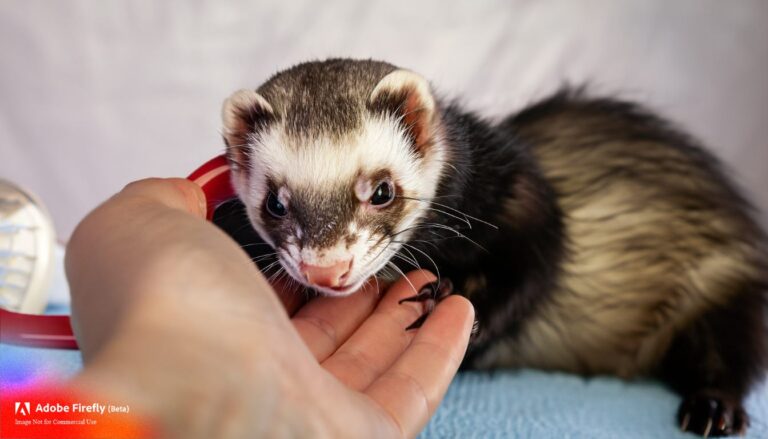
Have you ever noticed your ferret walking with their back arched? It’s a common sight that can leave many ferret owners concerned. But fear not, because in this article, I’ll delve into the reasons behind this peculiar behavior and what it could mean for your furry friend.
When a ferret walks with their back arched, it’s often a sign of excitement or playfulness. They may be feeling particularly energetic and ready to engage in some mischievous antics. However, it’s essential to distinguish between a playful arch and a more concerning one. In some cases, an arched back can indicate pain or discomfort, which requires immediate attention and veterinary care.
So, whether your ferret’s arched back is a playful display or a cause for concern, join me as we explore the various reasons behind this behavior and learn how to ensure your ferret’s health and happiness.
Understanding the Behavior of a Ferret with an Arched Back
When it comes to our furry little friends, it’s important to understand their behaviors and what they might be trying to communicate. One behavior that often captures our attention is when a ferret walks with its back arched. It’s a common sight and can be quite adorable, but what does it mean?
An arched back in a ferret can indicate a few different things:
- Excitement or Playfulness: Many times, a ferret will arch its back while walking or even during playtime. This is often a sign of excitement and enthusiasm. It’s their way of showing that they’re ready to have some fun.
- Flexing Muscles: An arched back can also be a way for ferrets to stretch and flex their muscles. Just like we do a little stretch after sitting for hours, ferrets have their own way of limbering up their bodies.
- Marking Territory: Believe it or not, a ferret’s arching back can also be a form of marking their territory. When they walk with their backs arched, they may be leaving their scent behind, declaring, “This is mine!”
It’s important to note that while an arched back is often harmless and playful, it’s crucial to differentiate between a playful arch and one that indicates pain or discomfort. As responsible ferret owners, we always need to be vigilant about our pets’ well-being.
- Lethargy: If your ferret is unusually tired or lacking energy, it could be a sign that they’re not feeling well.
- Loss of Appetite: Ferrets are known for their voracious appetites. If your furry friend isn’t eating like they usually do, it’s a cause for concern.
- Avoiding Touch or Being Aggressive: Ferrets might shy away from being touched or become aggressive when they’re in pain.
- Changes in Bathroom Habits: Any sudden changes in a ferret’s litter box usage, such as straining or blood in the urine, should not be ignored.
Common Causes of Ferret Arched Back Behaviors
When it comes to ferrets walking with their back arched, there are several common causes behind this behavior. As a ferret owner, it’s important to understand these causes in order to ensure the well-being of your furry friend. Here are some possible reasons why your ferret may be displaying an arched back:
- Excitement or Playfulness: One of the most common reasons for a ferret to walk with its back arched is simply excitement or playfulness. Just like other animals, ferrets may exhibit this behavior when they are feeling happy and ready for some fun. They may display an arched back while darting around or engaging in playful activities.
- Stretching and Flexing: Another reason for a ferret to arch its back while walking is to stretch and flex its muscles. This is a natural behavior that helps them to keep their bodies limber and agile. You may notice your ferret arching its back while waking up from a nap or after a period of rest.
- Territorial Marking: Arched back walking can also be a way for ferrets to mark their territory. They have scent glands located along their back, and when they walk with an arched back, it allows them to release their scent onto surfaces. This behavior is more commonly observed in unneutered male ferrets, as they tend to be more territorial.
- Pain or Discomfort: It’s important to note that not all cases of arched back walking are benign. Sometimes, this behavior can indicate pain or discomfort in a ferret. If your ferret’s arched back is accompanied by other signs such as lethargy, loss of appetite, avoidance of touch, aggression, or changes in bathroom habits, it may be a sign of an underlying health issue. In such cases, it’s best to consult a veterinarian for a proper diagnosis and treatment.
Understanding the reasons behind your ferret’s behavior is crucial for their overall health and happiness. While arched back walking is often harmless, it’s important to keep an eye out for any accompanying signs of distress. By being vigilant and observant, you can provide the best care for your furry companion.
Playful or Excited: When an Arched Back is Nothing to Worry About
When it comes to ferrets, their adorable and sometimes quirky behaviors can often leave us puzzled. One particular behavior that tends to catch our attention is when a ferret walks with its back arched. But before jumping to conclusions, it’s important to understand that not all arched backs are cause for concern.
In fact, a ferret walking with its back arched can often be a sign of playfulness or excitement. Just like cats stretching their backs or dogs wagging their tails, ferrets have their own unique way of expressing their joy. It’s their way of saying, “I’m having a great time!”
Ferrets are known for their boundless energy and love for play. When they get excited or engage in playful activities, their muscles may become tense, causing their back to arch slightly. So, if your ferret is bounding around, hopping from one place to another with an arched back, it’s likely just enjoying a stimulating play session.
Another reason why a ferret may walk with its back arched is to stretch and flex its muscles. Just like humans do yoga to release tension and improve flexibility, ferrets use this behavior as a natural way to limber up. So, if you see your ferret gracefully stretching its back while walking, it’s simply getting in a good stretch.
Lastly, an arched back can also be a way for ferrets to mark their territory. These curious creatures love to explore their environment and leave their scent behind as a way of claiming their space. When a ferret walks with an arched back and rubs against furniture or the corners of the room, it’s their way of saying, “This area is mine!”.
It’s important to remember that not all arched back behaviors in ferrets indicate pain or discomfort. In many cases, it’s a normal and natural expression of playfulness, stretching, or territorial marking. However, it’s always important to be observant of your ferret’s overall behavior and watch for any signs of distress or discomfort. By understanding why your ferret displays certain behaviors, you can ensure their health and happiness.
Now, let’s dive deeper into the signs that may indicate your ferret is in distress.
Recognizing Pain or Discomfort: When an Arched Back Requires Attention
It’s important to pay close attention to a ferret walking with an arched back as it can sometimes indicate pain or discomfort. While it’s true that an arched back can also be a sign of excitement or playfulness, it’s crucial to look for other signs of distress that can help determine if there’s an underlying issue.
If you notice your ferret walking with an arched back and displaying any of the following behaviors, it’s essential to take immediate action:
- Lethargy or decreased activity: A normally active and energetic ferret suddenly becoming sluggish or showing a lack of interest in their usual activities may be an indication that they’re experiencing discomfort.
- Loss of appetite: Ferrets are typically enthusiastic eaters, so a sudden loss of appetite is a red flag. If your ferret is not eating or showing disinterest in their food, it’s important to consult a veterinarian.
- Unusual postures or movements: Aside from an arched back, if you observe your ferret taking on other unusual postures or displaying unusual movements, such as hunching over, swaying, or limping, it may indicate pain or discomfort.
- Vocalization or excessive grooming: Ferrets in pain may exhibit vocalization, such as whimpering, squealing, or hissing. Additionally, they may spend excessive time grooming themselves in an attempt to self-soothe.
- Changes in urination or defecation habits: Any changes in the frequency, color, consistency, or odor of your ferret’s urine or feces may indicate an underlying health issue. These changes, combined with an arched back, warrant attention.
If you find your ferret showing any of these signs in conjunction with an arched back, it is crucial to seek veterinary care as soon as possible. A veterinarian will be able to examine your ferret thoroughly, determine the cause of their discomfort, and provide appropriate treatment.
Remember, as a ferret owner, you should always be observant of changes in your ferret’s behavior and seek professional help when there are concerns. By addressing any pain or discomfort promptly, you can help ensure the health and well-being of your furry friend.
How to Monitor and Care for a Ferret with an Arched Back
If you notice your ferret walking with their back arched, it’s important to monitor their behavior and take appropriate steps to ensure their well-being. Here are some tips on how to monitor and care for a ferret with an arched back:
- Observe their behavior: Take note of any changes in their behavior, such as lethargy, loss of appetite, or unusual postures or movements. These could indicate pain or discomfort.
- Watch for signs of distress: Pay attention to any vocalization, excessive grooming, or changes in urination or defecation habits. These signs, when combined with an arched back, may suggest that your ferret is experiencing pain or discomfort.
- Provide a comfortable environment: Make sure your ferret has a cozy and stress-free environment. Ensure they have a comfortable and supportive bedding, appropriate temperature, and access to fresh water and balanced nutrition.
- Monitor their food and water intake: Keep track of how much your ferret is eating and drinking. A sudden decrease in appetite or water intake could be a cause for concern.
- Seek veterinary care: If you notice any of the above signs in conjunction with an arched back, it’s important to consult a veterinarian. They will be able to examine your ferret, diagnose any underlying issues, and recommend appropriate treatment.
Remember, a ferret walking with their back arched can have various causes. While it is often a sign of excitement or playfulness, it can also indicate pain or discomfort. By closely monitoring your ferret’s behavior and seeking veterinary care when necessary, you can ensure their health and happiness.
And finally, it is essential to provide regular veterinary check-ups for your ferret to catch any potential health issues early on.
Following these steps will help you to be an attentive and responsible ferret owner, ensuring the well-being of your furry friend.
Conclusion
Understanding the behavior of ferrets walking with their back arched is crucial for their overall well-being. This behavior can indicate excitement, playfulness, stretching, muscle flexing, or even territorial marking. However, it’s essential to note that an arched back can also be a sign of pain or discomfort, especially when accompanied by other distress signals.
To ensure the health and happiness of our furry friends, it’s important to be observant and vigilant. Look out for signs such as lethargy, loss of appetite, unusual postures or movements, vocalization, excessive grooming, and changes in urination or defecation habits. If any of these signs are present alongside an arched back, seeking veterinary care is crucial.
In caring for a ferret with an arched back, create a comfortable environment, monitor their behavior closely, and keep a watchful eye for any signs of distress. Additionally, make sure they have access to fresh food and water, and seek veterinary care promptly when necessary.
By understanding the reasons behind a ferret’s behavior and providing regular veterinary check-ups, we can ensure their health and happiness for years to come.






